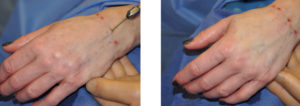Do your hands give away your age? In many people, the hands are just as revealing as our faces about our age. But our faces understandably get much more attention and the hands are often forgotten. (but not unseen by others) As we age, our hands (particularly women) loose that once plump fullness and youthful look. Aging hands become thinner with vein and joint exposure, loose creapy skin, and brown spots over the back of them. These changes occur from chronic sun exposure and extensive use. While hand creams are a good first line of defense, they are not enough to produce a dramatic rejuvenating effect.
Adding volume back into the hands through injectable fillers is a good way to lessen the prominence of the veins and give a more plump appearance. The question is….which injectable filler? In my experience, you have 4 options…three off-the-shelf and one operative (which is only done if you are in the oprating room anyway for other procedures)
While all of the hyaluron-based injectable fillers (e.g., Restylane, Juvaderm) are extremely well tolerated, their effects are too short-term and do nothing to stimulate actual collagen tissue ingrowth so I prefer not to use them in the hands. The particulated fillers, such as Radiesse and Artefill, are better options as they last longer and may actually help stimulate favorable tissue ingrowth for longer-term results. Radiesse uses resorbable ceramic beads in its mixture so the effects are immediate but the beads are eventually resorbed over a year or so. It is also white in color although much of this is masked by the color of the skin. Artefill uses non-resorbable plastic beads in a collagen base which is much more likely to last longer and produce a better tissue-thickening result. Because both particulated fillers have a tendency for ‘clumpiness’ and irregularities, injection technique is critical and it is best to not inject too much at once. Afew staged treatments (spaced 6 to 8 weeks apart) slowly adding volume, and doing daily massage over the injected areas is the best way to ensure a smooth-looking result. Sculptra is another off-the-shelf filler option that is really like injecting ‘liquid plastic’ rather than a bead or particulated approach. Its material is resorbable over time and you have to be really careful about adding too much volume at once as it can cause local tissue reactions. Which one of these off-the-shelf injection materials is better for the hands is not yet known….and none of them are FDA-approved as of yet for use in the hands.

Hand rejuvenation, sometimes referred to as a ‘hand lift’ (erroneous term but catchy nonetheless), is based on the concept of restoring volume. Whether it is from a synthetic injectable filler or your own fat, short-term results appear to be quite good. Whether they will stand the test of time and what complications may yet emerge is not yet known. But at this point in time, I will give it at least a temporary thumbs up with the other four fingers still in neutral position.
Dr. Barry Eppley
Indianapolis, Indiana


